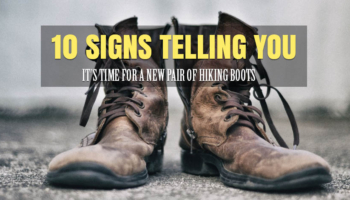
Hiking is a great outdoor activity, as it’s both rewarding, challenging, and fun. As long as you’re packing right, wear the proper gear and clothing, you should be able to get the best out of your hike every single time.
If you’ve been hiking for a while, that some things can make a difference, helping you or jeopardizing the whole outdoor adventure. Hiking boots are one piece of garment to name, that can help you climb easier, brake effortlessly when descending, or keep your feet dry after stepping into a puddle. At the same time, hiking boots can cause spray ankles, blisters, and sweaty feet at the end of the day.
Needless to say, hiking boots are one piece of gear that you should always consider when preparing for your next hike. Where you hike, for how long, or how experienced you are, make criteria to consider when buying hiking boots.
There are many criteria to consider when cruising for your next pair of hiking boots, and the material used for the upper part is one, to begin with. Taking a brief look at the market will help you see that you have to choose between two main categories: leather and synthetic.
How should the upper part of hiking boots be?
The upper part of your hiking boot is mainly for protecting the foot against the elements. More often than not, you want it to be long-lasting, breathable, and at least water-resistant for best performance and comfort.
Uppers of hiking boots can be made with leather (which also comes in various types; details down below), synthetic materials (nylon mesh, Cordura, polyester, and such), or a combination of leather and synthetic materials.
No upper material is perfect, and each has its ups and downs. At the end of the day, you should always select material according to your hikes’ particularities, any foot-related problems, and season.
Leather hiking boots- but which type of leather is better for hiking?
As you may have realized by now, making an informed decision when buying hiking boots or shoes doesn’t come easy. The more you know about materials, build, or features on hiking boots, the higher the chance for you to get the best pair of boots right from the start. This time, let’s start with a closer look at the types of leather used on hiking boots.
Full-grain leather
Full-grain leather is mostly utilized on rugged hiking boots, with backpacking and mountaineering boots as the most common. These boots are long-lasting, rigid, resistant to abrasion, and ready to take a beat. As the full-grain leather is thick, these boots will provide better ankle support, feeling a tad stiff when out of the box. Full-grain leather requires very little stitching, which expands the durability.
Full-grain leather is water-resistant, but waterproof protection can be added. The main downside is that it’s less breathable, more massive than other leather, and pricier too.
Should you need hiking boots for backpacking, mountaineering, or technical hikes, it’s worth to pay the extra buck for boots made with full-grain leather.
Split-grain leather
Split-grain leather hides with top-grain removed, so the leather is thinner than the full-grain type. Most of the time, split-grain leather is mixed with polyester or nylon mesh, which is why hiking boots become lighter, more delicate than full-grain leather boots.
As the leather is thinner, these boots are also more breathable, becoming a better choice for hot summer hikes or light backpacking. Since the spit-grain leather is combined with textiles, a lot of stitching is required too, which reduces the boots’ lifespan.
Split-grain leather is typically used with nylon/polyester mesh upper in hiking shoes and lightweight hiking boots.
Even if split-grain leather boots are light, breathable, and affordable, they’re also less durable and less resistant to abrasion than full-grain leather models.
Nubuck leather
Nubuck leather refers to the top-grain leather that was buffed/sanded to look like suede. Nubuck leather is affordable, soft, light, and even more breathable than full-grain leather. At the same time, this type of leather has a lower resistance to water and abrasion.
Boots made with nubuck leather make a dependable option for backpacking or light mountaineering and more challenging hikes and tough trekking.
These boots are less expensive, more breathable, and lighter than full-grain leather boots but may present lower resistance to abrasion too.
When are synthetic materials, the right choice for hiking boots?
Synthetic materials typically include porous nylon mesh and stiff synthetic materials for better support and durability. They’re lighter than leather, which is why they have better breathability.
Synthetic materials will dry faster than any leather and cost less than any leather too. When we take a look at the downsides, we should note that synthetic materials have lower resistance to abrasion and durability.
Lightweight hiking boots, trekking shoes, or hiking shoes for the summer are typically made of synthetic materials.
How should you choose?
It would help if you never decided only to take one aspect of the problem. Leather boots surpass any other synthetic materials in durability and ruggedness, but the type of leather can make the difference.
Even if the following tips don’t comprise all aspects to consider when selecting your hiking boots, you should check them anyway:
When will you hike?
If you’re going on a summer hike, you want your hiking boots to be highly breathable, in which case synthetic boots make the best options. Boots made with nubuck or suede may also work, but they will never provide the same ventilation level as synthetic boots.
Should you go in the winter, you need to go with the opposite, with full-grain leather as the most reliable and rugged material for your boots. Don’t forget that insulation is essential in hiking boots for the winter, but full-grain leather remains the main factor for ruggedness in the winter.
How technical is your hike?
Should you plan to have some light hikes every couple of hikes every year, you shouldn’t aim for the most rigid or most durable pair of hiking boots. It’s not essential to get the high-dollar boots made of full-grain leather if you only hike five times a year. Some split-leather hiking boots or combination with synthetic will do.
On the other hand, if you like technical hikes, with rocky and steep trails, you should always get the most rugged and most rigid boots made with full-grain leather. Also, numerous features will make them safe for your strenuous hikes, so look into that too.
Do you have any foot-related conditions?
People with various foot-related problems like to hike. Even if hiking is strenuous and may aggravate their conditions, these people may still try light hikes, but only if wearing the proper pair of hiking boots.
People with weak ankles, for instance, should look for full-grain leather boots that are rigid and efficient for ankle support. Hikers with bunions, on the other hand, may have a better comfort with boots made with split-leather or synthetic, as they need a soft upper.
One last piece of advice
Always go shopping with consideration to your particularities, any health conditions, and information about your options. You should also take a look at your wallet as it can be the decisive factor at some point.








